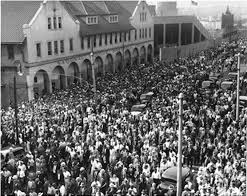James Edward Gaffney (March 7, 1868 - August 17, 1932) was the owner of the National League's Boston Braves from 1912 through 1915. Under his leadership, this last-place team became the pennant winner, in a baseball success story that anticipates the "Miracle Mets" of 1969 by more than half a century.
 |
| Gaffney's house on Broadway and Washington |
But baseball became Gaffney's passion. In 1911, It was rumored that Gaffney lent money to his friend Clark Griffith, manager of the Washington Senators to purchase an interest in the team. (McClures Magazine, May-October 1912, v.39, p. 241). In December of that year, Gaffney financed the purchase of the Boston National League team for $187,000. The team had not won since 1898 and Gaffney was prepared to put another $100,000 into it to turn it into a winning team (Philadelphia Inquirer, 12/23/1911, p. 10). With his partner John M. Ward, a former player and manager, Gaffney hired a new manager in 1913 (George Stallings) and beefed up the bullpen. The team, which had been variously named the Beaneaters, the Doves and the Rustlers, now became the Braves. New York's Tammany Society was named for Tammany or Tammanend, a Delaware Indian chief, and the members were known as "braves". The press had named Gaffney "the Brave of Tammany Hall" and Gaffney thought it a great joke to flaunt the New York Democratic machine in the face of the conservative Boston brahmins.
Ward quickly lost heart and sold out to Gaffney, but the newly-energized team went from last place in early July 1914 to first place at the end of August. They defeated the New York Giants for the National League pennant and went on to sweep Connie Mack's Philadelphia Athletics in the World Series.
With this momentum behind the team, Gaffney took the opportunity of creating what was then the largest and most expensive ballpark in the country. Braves Field was to be built about four miles outside of Boston center and would hold 42,282 seats.
 |
| Braves Field, c1915 |
16,691 [would] be in a one-story grandstand, so constructed that a second deck [might] be added later; 18,015 [would] be built in bleachers back of the first and third bases, admission to which [would]be 50 cents, and 5,336 seats [would] be provided to the right of center field for the 25-cent patrons. (Idaho Daily Statesman, 12/29/1914, p. 2)
Gaffney wanted the playing field to be large enough so that it would be possible to hit an inside-the-park home run in any of the outfield directions. He used his connections to erect a departure station within the stadium walls and convinced the Boston Elevated Railway System to construct a closed loop from the Field to the mainline tracks. Easily accessible by trolley, the new steel stadium was immediately christened "the world's greatest baseball park" by Baseball Magazine.
Unfortunately, the Braves did not live up to their promise and soon declined in popularity. Gaffney suffered the same fate, as he became implicated in graft and corruption scandals in New York State and gradually faded from the public arena. The home in Cedarhurst was sold in 1931 to an industrialist and Gaffney died the following year while vacationing in East Hampton.
Visit our local history display on James Gaffney
Lower Level near the Reference Desk
Further Information
- Braves' Field: an imperfect history of the perfect ballpark (bostonbaseballhistory.com)
- Society for American Baseball Research: Braves Field
- Tammany Hall (from the Eleanor Roosevelt papers Project, George Washington University)
- James E. Gaffney: Find-a-Grave.com
- Voigt, David Quentin. American Baseball, vol. 2. University Park, PA : Pennsylvania State University Press, 1983, p.41-2.
- Seymour, Harold. Baseball the Golden Age, vol. 2, Oxford University Press, 1971.


2 comments:
Thank you for this wonderful piece.
I am a descendent of James E. Gaffney; there are several errors in this article that appear in multiple sources. Gaffney was never a policeman and Murphy was not his brother-in-law.
Family stories say that Gaffney often kept a donkey on the lawn of his Cedarhurst home. There are 2 homes on W. Broadway he built on speculation, then gave to his sisters. One is still in the family.
Gaffney is the reason Gov. William Sulzer was impeached. After he sold the Braves, he remained active trying to buy other clubs and in thoroughbred racing.
Thank you so much for your comments. I have edited the article to exclude the erroneous information. MV
Post a Comment